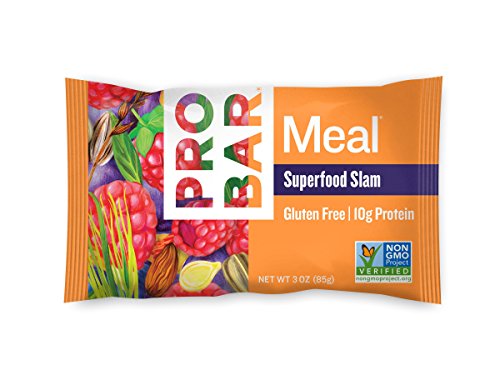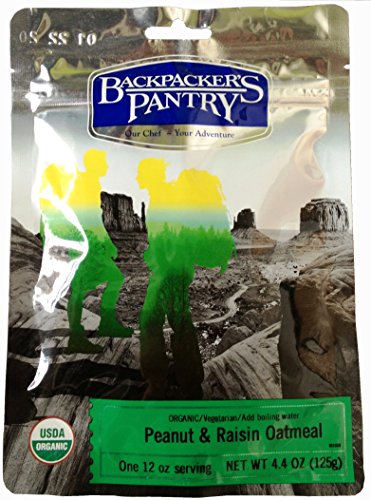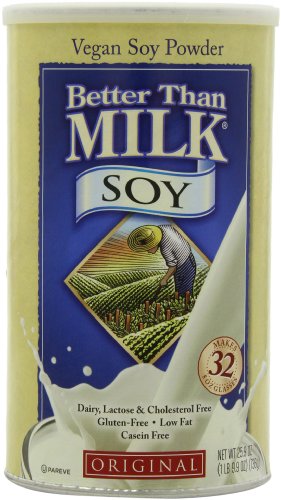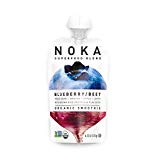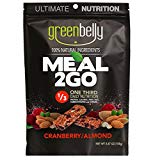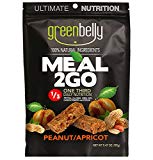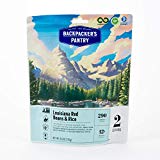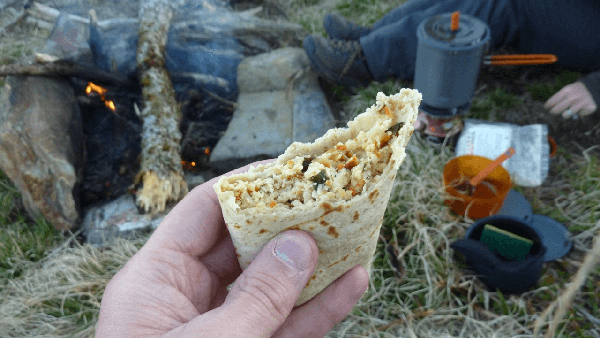
Trying to customize backpacking meals isn’t always easy. In fact, making my own custom backpacking meals was a major driving factor of several of my own long-distance trips.
More...
Some hikers need meals packed with calories. Some of us want vegetarian meals. Others need to stay within the boundaries of dietary restrictions such as vegan food preparation. Today’s article is all about serving those vegan backpackers!
By the end of this article, you should have a better understanding of what it takes to create tasty vegan backpacking food. What are the best types of meals? How do you make it all work? Is it even possible?
Don’t worry we’ll clear it all up for you, just stick with us as we present The No BS Guide to Vegan Backpacking!
Advantages of Eating Vegan
Many of you may already be vegans yourself so you probably don’t need to hear this. Some may be considering the choice and for those, here are a few reasons many hikers eat vegan.
Among the vast sea of reasons from health to personal choice, these reasons tend to stand out more often.
Some sources say that meat production, particularly beef, is hugely contributing to global warming. Of course, as outdoor lovers, this is particularly on our mind (though it probably merits consideration by all).
If global warming isn’t enough to convince you, other arguments can be made for the health benefits of going vegan. Those may include:
Vegan dietary restrictions are also a great motivator for backpackers to learn more about how to make their own meals. Making your own meals is great because you can make cheaper, lighter, and more healthy options for yourself than otherwise would be the case buying off the shelf.
As a backpacker, the more involved you are with every step of the trip planning and prep process, the better and more efficient you can make every inch of your processes. That means lighter pack loads, customized meals, and improved cooking options which we’ll talk about later!
Nutrients on the Trail
Disclaimer
I am not a nutritionist, food scientist, or doctor. Please consult a health expert for accurate, detailed, and specific information that pertains to your individual health.
How Much Does Nutrition Matter?
On the trail you’ll find two different camps of thought regarding nutrition and meals. Camp one says, eat whatever you want and just focus on high loads of calories to keep you going. Camp two says you should be worried about balanced meals, dehydrated veggies, and rounded nutrition.
You’ll find a lot of extreme ultralight, ultra-distance, hikers hanging out somewhere in or around camp one. Meanwhile, you’re more likely to find casual weekenders or those who highly value careful diets in camp two.
While I’m certainly not going to say that you can live off of Snickers bars alone in perpetuity, I will say many very successful long-distance thru hikers have proven the effectiveness of eating “bad for you” food on the trail.
How long can you go on an imbalanced diet? I have no idea, that’s probably a question for a sports medicine or nutrition expert. I will say, however, that I wouldn’t spend too much time sweating the small details of nutritionally perfecting every meal of every day on the trail.
Remind Me What Nutrients are Again....
Generally nutrients are broken down into:
Carbohydrates include simple carbs (think table sugar) and complex carbs (think pasta). While the details of what they are and how they affect the body are far beyond the scope of this article we can remember a few things. Simple carbs break down and burn fast. The body uses these rapidly! Complex carbs, however, are a slow burning fuel that will do a better job keeping you going over time.
Proteins come from many sources and there are many different proteins. It is a misconception that meat is the “best” source of protein. Proteins are made from different combinations of 20 amino acids that can be found in various food sources for humans. These sources include beans, peas, tempeh, lentils, almonds, spirulina, the list goes on…
Fats, while often looked down on in daily life, are in fact the life of the party on the trail. Fats are some of the most dense sources of calories - thus their bad reputation. However, on the trail, more calories means more fuel and more fuel means hiking further and longer (and extra body heat fuel in the winter).
Finally, vitamins and minerals are found sprinkled around many sources in the food world. They’re the final building blocks of the puzzle that is the human body.
Pro Tip
Please consult your doctor before getting lost on the internet trying to self-diagnose your personal nutrient and vitamin needs.
How do Nutrients Apply to the Trail?
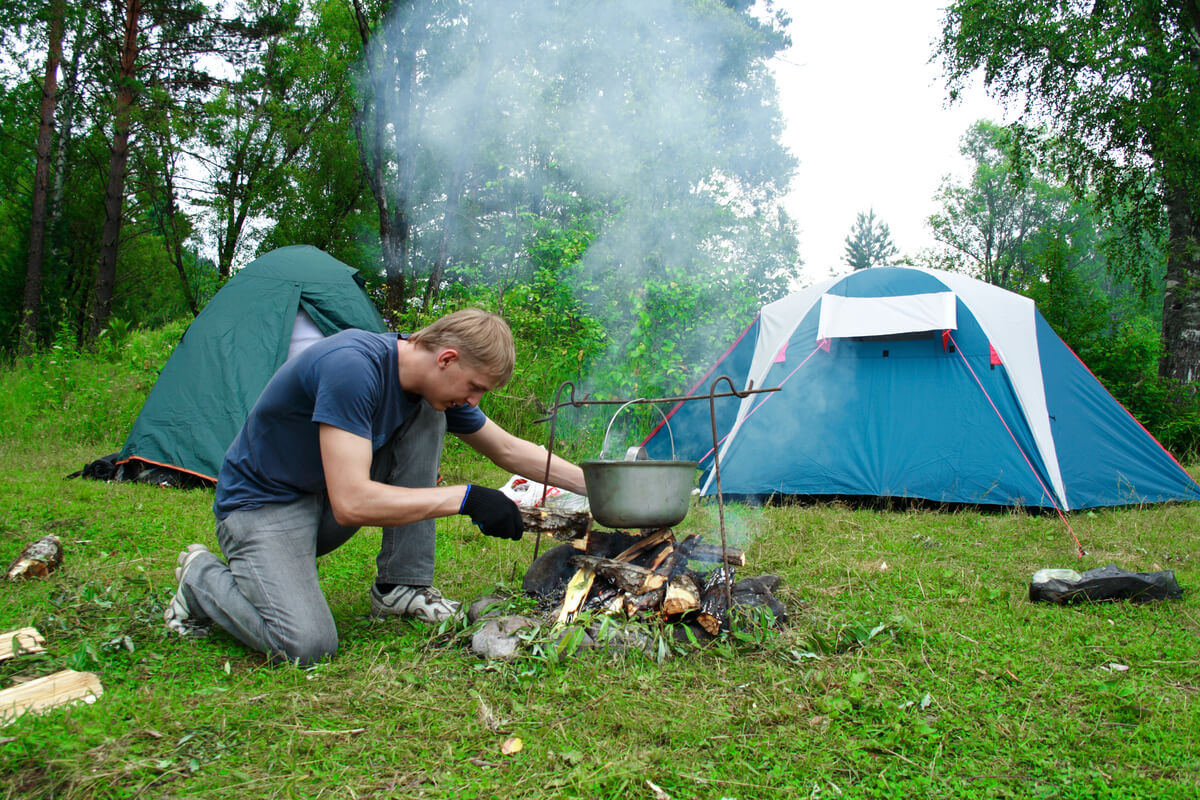
I think most of this answer lies in your personal approach. How does diet and nutrition fit into your life at home? It’s not much different on the trail.
I feel that it’s important to keep in mind that the overwhelming majority of backpackers are only on the trail for a day or two. I would guess that probably 95% of backpackers spend 2-7 days on the trail per trip at most.
Because of this, the effects of nutritional changes are very minimal at best. Except for very rare and extreme cases, the human body isn’t dramatically affected by a change in diet for a few days. Having more sugars or fats than you typically do in your diet for a 4 day backpacking trip won’t really affect anything (with the exception of people with preexisting medical conditions).
Where things get a bit more complicated is when we apply nutritional deficiencies to long-distance backpacking. If you’re on the trail for, say, 6 months hiking the AT then you’ve got enough time to see nutrition make an impact over the long haul.
I can’t stress this enough - please consult your doctor or nutritionist if you plan to be on the trail long enough to worry about nutritional deficiencies!
For your average weekend or week long trip, however, don’t get too wrapped up in splitting hairs over nutrition unless you already know you have a health reason to do so.
I think it’s reasonable to say that spreading out and rounding out your meal intake is sensible in almost every conceivable case. For instance, when packing my meals I try to rotate dinners between beans and rice, cheesy parmesan potatoes, couscous, etc. While these may not be perfectly balanced meals, it helps a lot more to spread out nutrient intake than always eating the same exact combination of ingredients every dinner.
What are the Best Vegan Backpacking Foods?
Let’s start by clarifying what “best” means in this particular instance. Since taste is subjective we won’t get distracted by that topic. Instead, we’ll look at which vegan backpacking foods pack in the most caloric density - or calories per ounce.
Caloric density is an important measure of a food’s fuel potential on the trail. Since every ounce counts when you’re carrying it on your back for days at a time, there’s a strong case to be made that the “best” backpacking foods are the ones with the relatively highest caloric density compared to whatever else you’re considering.
I’ll also give a shout out to some vegan “superfoods” that are loaded with good-for-you-stuff. Since calories alone won’t keep you alive forever, some balanced vegan superfoods deserve a mention.
Best Vegan Calorie Smashers
Best Vegan Superfoods for Backpacking
How to Use This Information
Please understand that there is a lot more to proper nutrition and veganism than this article covers and most of it is beyond the scope of my personal knowledge. I highly encourage you to seek professional help when making health-based nutrition choices.
If you’re in the camp that likes to cook for enjoyment and eat for pleasure on the trail I know you’ll find many like-minded folks to learn and grow with as you adventure! Go out, explore new foods, hike with other vegans, and learn tons. There are so many good resources out there.
If you’re like me, you may be looking for high-fuel foods for long 30+ mile days with pack weights under 10 pounds. Being vegan while pushing and optimizing your food choices for on-trail performance can be tricky. Start with this information and go deeper! Look for more foods, count calories, and spend endless evenings in front of your favorite excel spreadsheet.
Regardless of which of these schools of thought applies to you, this article is meant to be a starting point and not a comprehensive guide to everything vegan on the trail. Keep learning and have fun!
Challenges of Vegan Backpacking
As a vegetarian myself I can speak somewhat to the load of challenges you can expect to face when backpacking and prepping for a trip. Of course, as veganism is more restrictive yet, the challenges will be proportionately amplified.
One challenge is finding vegan meals ready-made. Over the last few years, this challenge has diminished greatly as veganism is widely represented in the backpacking culture group. For that reason, manufacturers have recognized the demand and made vast strides in offering more numbers and greater diversity of vegan backpacking meals.
Another challenge can sometimes be as simple as meal diversity. On the trail water weight is a big problem in foods so fresh fruit and vegetables are usually a no-no on the packing list unless you want to break your back carrying the weight.
Instead, you’ll have to find dehydrated fruits and vegetables which are much rarer and significantly more expensive than fresh ingredients. Of course, a fresh apple or carrot here and there won’t break the scales but don’t plan on packing full meals of fruits and veggies! Fresh foods also have dramatically reduced lifespan on the trail so beware spoilage!
Premade vs Homemade
All backpackers have two options for meals on the trail. Either you have to do it yourself or you can buy premade meals. DIY meals are often done in the form of Freezer Bag Cooking (FBC) and storebought meals are usually premade just-add-water freeze-dried foods.
There’s nothing inherently wrong with prepackaged meals or freeze-dried meals. So, don’t take this as a manifesto against those styles. However, DIY style meals done with FBC have several advantages. If you want the deep-dive guide to Freezer Bag Cooking you’ll need to head over to our sister-site Hike With Less where you can take a full course in FBC DIY.
One factor that many hikers find appealing is the cost savings associated with making your own meals. While prepackaged meals can cost anywhere from $4 – $8 per meal, an FBC meal can cost as little as $0.40 – $0.80 per meal and you can fully customize the ingredients to your diet and tastes!
There’s something to be said about the convenience factor of buying premade, however. Some of us just don’t need to make custom meals. Maybe you’re okay with the flavor, calorie count, or price of premade meals and you just don’t have time to fiddle around with making your own.
Manufacturers like ProBar and Outdoor Herbivore offer meal bars or full meals from about $2.50 to about $9 depending.
So, what it comes down to is a personal choice. Some of us want to make our own meals to customize nutrition or flavor. Others prefer to buy meals to save time and hassle. Either way is totally fine and you’ll need to make the choice that is right for you!
Best Dried Vegan Backpacking Foods
Breakfast
I personally like no-cook breakfasts for light and fast packing. however, when it’s time to slow down or you can carry some extra gear (like car camping or canoe camping) then hot meals are back on the menu for many of us!
I tried to cover both hot and cold breakfast ideas here and keep all of them vegan. Let us know if you have a favorite vegan breakfast that we missed.
Oatmeal
Oatmeal is such a simple breakfast that we sometimes forget about it. In fact, it’s so simple that it hardly merits paying for premade oatmeal but if you’re interested Backpacker’s Pantry makes Organic Blueberry and Peanut Raisin Oatmeal among other flavors.
If you want to make your own, all you need is some oats of your choice, dehydrated fruit, and some nuts of your choice. You’ll save a ton of money in the process.
Breakfast Scrambles
If you love the potatoes and hash type breakfast characteristic of the old-timey-time lumberjacks but you need it in the vegan form we’ve got you covered. This is a hard one to make at home but you can get the Sunrise Tofu Scramble from Outdoor Herbivore premade.
I also like the looks of the Denver Veggie Scramble from them as well and it has the hearty scramble feel of a major breakfast meal.
Cold Breakfasts
Don’t want to boil water for breakfast? That’s fine, it’s better for your overall pack weight anyways. Eating a cold breakfast can dramatically reduce cooking needs like hardware and fuel.
Besides, there’s something refreshing about a good old cereal breakfast.
There’s no need for expensive meals here though many vegan backpacking meal guides might convince you otherwise. Many mainstream kinds of cereal are vegan by nature and might surprise you:
- Captain Crunch
- Mini Wheats
- Life
- Many Kashi kinds of cereal
- Many Nature’s Path cereals
Smothering these cereals in water will suck though, so don’t do it. Instead, try reconstituted soymilk powder. Put some cereal and a corresponding scoop of Soymilk Powder in a bag and just add water in the field to make a tasty, crunchy, cheap breakfast!
Lunch
Lunch isn’t hard because there are so many options out there. Meal bars, snacks, and any light foods can easily be made into good lunches as long as they meet vegan standards.
Look for vegan crackers, chips, cookies, bars, and GORP to round out your meal plans for the midday stretch.
I also really like foods that can be hydrated as you walk such as couscous, tabouli, and other zesty options!
Maybe these would be better listed as a snack but I think they make a solid lunch option for light eaters or when combined with additional foods.
I’m not suggesting one of these bars makes a full lunch, but when taken with some other foods (maybe another type of food bar) it should do the trick!
I will say right up front that these have a decent amount of water weight. For that reason, they’re not the best from a standpoint of caloric density if you’re interested in optimizing that. However, they are loaded with tons of tasty flax and plant proteins that can be hard to get on the trail.
Lentil salads are an awesome option for hot summer hikes. I love lunches that you can hydrate mid-morning and eat at lunch and this one makes the cut.
Add a half cup of water during a break about 15 minutes before you’re ready to eat. By the time you stop for lunch, you’ll have a fully hydrated light lunch meal. Best for super-hot summer hikes.
Another easy to prepare no-cook lunch recipe is the Lemony Herb salad. At 123 calories per ounce, it’s not too bad on caloric density, either.
Pro Tip: Add a shot of olive oil to boost calories!
Snacks
Snacks and bars for me always crossover into lunch. I usually eat some as I walk midmorning, maybe one for lunch, and one midafternoon. Of course, they can constitute their own meals as well so here are some snacky ideas!
Another one of those lunch/snack crossovers, the ProBar line of meal bars is always a solid choice. All their bars are vegan and most are gluten-free as well if that’s important (or necessary) to you.
I love their fruit-based bars but they have plenty of protein bars and meal bars that have a hearty complexion like the peanut bars.
Okay, hold on to your vegan debating britches and get ready to enter muddy water. Essentially, if you feel that honey is vegan you’ll love these meal bars. If you feel that honey is not vegan then skip this.
Both the Cranberry/Almond and Peanut/Apricot blend meal bars from Greenbelly count as vegan assuming you don’t mind honey. According to Greenbelly’s site, however, the chocolate variety contains milk so it’s a no-go.
I like Greenbelly’s products because they’ve put a lot of thought and work into making meals that are reasonably priced, well-rounded in terms of nutrition (though I’m no nutritionist), and tasty. In my book, they get a solid recommendation next to ProBar an older standby for me.
GORP
Good old raisins and peanuts, my arch nemesis. I ate so much GORP when guiding backpacking trips that it’s now an outlaw on my personal packing list.
GORP isn’t bad, though. In fact, you can customize it to fit your tastes! Love raisins? Add extra. Hate pecans? Ditch em!
Don’t bother buying premade GORP because you can make it for fractions of the price by visiting the bulk nuts aisle of any grocer.
Dinners
Backpacking dinners are one of the meals that always cause panic among hikers. Fortunately, there are a handful of ingredients that can easily be rearranged into various recipes to make great meals and many of them are (or can be) vegan.
Staples like dehydrated beans, rice, couscous, falafel, and tortillas can go a long way toward solving real problems for vegan hikers seeking a tasty dinner meal.
You’ll be surprised at how easy it is to make a familiar meal into a backpacking meal.
A new addition to the lineup at Backpacker’s Panty, the Red Beans and Rice is a twist on the classic beans and rice meal. The price might be a bit steep when you consider how cheap it is to make your own FBC beans and rice meal…
FBC Beans and Rice
You’ll need:
- Minute Rice
- Taco Seasoning
- Fritos (yes they’re vegan)
- Dehydrated refried beans
For the full recipe, you can see our step-by-step guide to creating your own FBC meals at Hike With Less where we teach you everything you need to get a lighter pack with tastier meals!
There are tons of variations and spins you can put on this meal so get creative and make it fit your style!
A smaller up and coming company called Backpacker’s Bistro is making some good vegan meals. They’re a bit pricey but not wildly unusual.
Fortunately, they are offering some unique and new flavors we haven’t seen too much of yet. This mushroom pilaf makes the list because it’s a fresh recipe to avoid burnout on the trail.
Make some falafel of your favorite brand and keep it pretty dry. You want a consistency that will stick together well.
Press these into small patties like mini burgers.
Get a pan going with some hot oil and sear the falafel patties.
Now add your favorite burger toppings like onion, mustard, and ketchup and you’re ready to go with some mini falafel sliders. Bam!
This one makes the cut because curry meals have such a blast of flavor. Trail meals often border on bland and boring requiring copious additions of hot sauce to keep your tastebuds alive.
Katmandu Curry from Backpacker’s Pantry brings a flavorful tongue-punch of tasty ingredients that will interrupt an otherwise boring lineup of meals if you’re struggling for inspiration.
Conclusion
Let’s be clear – there are a bazillion ways to make and enjoy backpacking meals. Some of us want the lightest meals with no cooking. Some prefer to carry everything but the kitchen sink and make cooking a top priority.
No matter what your disposition is on the matter, there should be some good ideas in here for you going forward. Look through our list of meals for ideas.
I tried to include both premade and homemade options on our list. I also took the effort to point out when and how to make your own foods for variety or to save money. The simple fact of the matter is that many vegan backpacking meals can be made at home easily and inexpensively (plus you know exactly what goes into it).
If you want to know more about planning your own meals, making recipes, or cooking in the field using lightweight and simple methods like FBC just make sure to stop by our sister-site Hike With Less and give us a shout.

